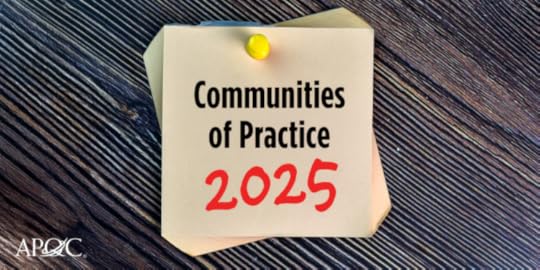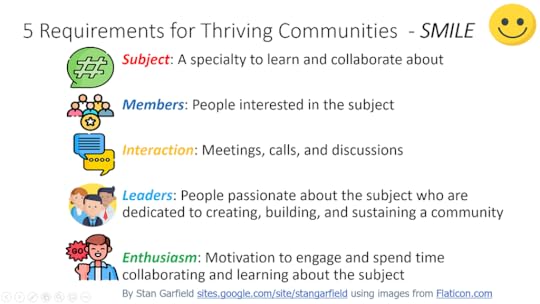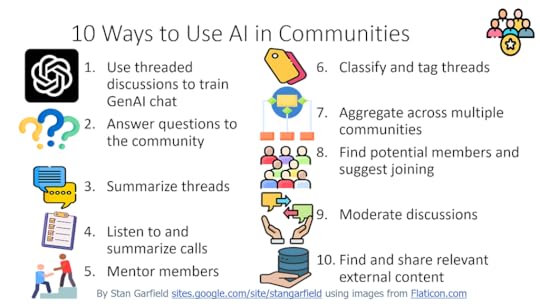Communities of Practice in Modern Organizations: Insights on the APQC Survey Report

APQC invited me to blog about my insights on their 2025 Communities of Practice in Modern Organizations Survey Report. After reviewing the details in the report, here are my thoughts on the results. In each section, the survey answers are listed first, followed by my comments.
CoP Organizational ModelFormal, functional: CoPs are governed and funded at the level of a single business division/department/functionInformal, functional: CoPs can be started by anyone in the business division/department, but there’s no governance or funding model in placeFormal, enterprise level: CoPs are centrally governed and funded at the level of the entire organizationInformal, enterprise level: CoPs can be started by anyone in the organization, but there is no centralized governance or funding model in placeOnly 23% of participants in the survey reported using number 3 (Formal, enterprise level) — the best choice. The other models result in redundant communities and with communities that fail to span boundaries to connect people across organizations. Funding can come from functions, but governance should be at the enterprise level.
Primary CoP Goals for OrganizationDevelop and disseminate proven practices, guidelines, and proceduresFoster collaboration and sharing across geographiesEnhance networking and professional developmentProvide a forum for day-to-day problem solving and learningInnovate and create breakthrough ideas, knowledge, and practicesEnsure critical knowledge is reused across the organizationIdentify and prioritize areas of critical knowledgeOrganize, manage, and steward bodies of knowledgeThese are all admirable goals. Only 55% reported number 4 (day-to-day problem solving and learning), which should be a fundamental goal for most communities. Number 2 should have the text in bold added:
2. Foster collaboration and sharing across geographies and organizational boundaries
Requirements to Launch a CoP Within OrganizationsIdentify potential participantsAlign to a business priorityCreate a charterSecure key CoP rolesIdentify an agenda and initial topics to coverThere are other important requirements. Before starting a new community, these questions should be answered:
Is there an existing community that covers the topic or a related one?Is the topic defined using widely understood terminology?Are people likely to want to join in sufficient numbers to achieve critical mass (100 or more)? They should identify with it: view themselves as specializing in it.Is the CoP leader willing to spend the time it takes to lead a community?Is the CoP leader willing to measure the community by the established health indicators (e.g., activity and membership)?If the answer to number 1 is “no” and the answers to numbers 2–5 are “yes,” then the new community should be approved. Otherwise, an existing community should be used.
There are five elements that communities need (SMILE):
Subject: A specialty to learn and/or collaborate aboutMembers: People interested in the subjectInteraction: Meetings, calls, and discussionsLeaders: People passionate about the subject who are dedicated to creating, building, and sustaining a communityEnthusiasm: Motivation to engage and spend time collaborating and/or learning about the subject Roles in Place to Support CoP EffortsSubject matter expertsCore group of membersFormal CoP leader(s)Moderator or facilitatorExecutive sponsorContent managerIT support roleLibrarian
Roles in Place to Support CoP EffortsSubject matter expertsCore group of membersFormal CoP leader(s)Moderator or facilitatorExecutive sponsorContent managerIT support roleLibrarianThese are all good roles, and they need not be performed by separate individuals. Communities can succeed with just leaders and members. The leader can also be moderator, facilitator, content manager, IT support, and librarian. The members can be subject matter experts and core members.
Skills and Abilities Most Important for a Successful CoP LeaderPassion for the topicFacilitation skillsActive practitioner within the CoPLeadership abilityChange management and communication skillsRespondents indicated 43% for number 1, 40% for number 2, and 35% for number 3, which are reasonable. All five of these are good for CoP success.
Ways to Encourage/Enable People To Participate in a CoPPromoting a culture that encourages and supports participationCommunicating how it is important to their jobMaking participation a professional development opportunityRewarding and recognizing participationThese two should be added:
5. Setting formal performance goals for participation
6. Setting promotion requirements for active participation
30% reported that their organization does not explicitly provide resources or processes to encourage participation, and only 22% reward and recognize participation. These are disappointing results.
Critical Success Factors Needed to Sustain a CoP ProgramMember engagementCulture of the organizationOrganizational leadership supportAlignment to business objectivesLeadership within CoPs57% chose “member engagement,” but that needs to be better defined. It should not mean that all members need to post to online discussions, but it should mean that all members need to pay attention to community discussions and activities. Using that definition, the number should be close to 100%.
Critical success factors for a communities program include:
A single, global, cross-functional community is available for each major specialty and role.Everyone belongs to at least one community, including the one most relevant to their work.All community members pay attention to the discussions and activities.A single platform, well-suited for communities, is used for all CoPs. For example, in the Microsoft 365 environment, Engage is used, not Teams.There is a single communities directory listing all CoPs and linking to the sites where people can view online discussions and join.For individual communities, they are:
Compelling topic: The members and potential members must be passionate about the subject for collaboration, and it must be relevant to their work.Critical mass of members: You usually need at least 100 members, with 200 being a better target.Committed leader: The community leader should know the subject, have energy for stimulating collaboration, have sufficient time to devote to leadership, and then regularly spend time increasing membership, lining up speakers, hosting calls and meetings, asking and answering questions, and posting information useful to the members.Regular events: Calls or in-person meetings are held regularly.Active online discussions: There are regular posts, multiple replies, and no unanswered questions.Number of Active CoPs in an Organization
1–56–1011–1516–20More than 2035% reported 1–5 communities and 24% reported more than 20. If the former are small organizations and the latter are large ones, these number make sense. The ideal number of communities is exactly one for each topic of importance to the organization and to its people for which there are sufficient numbers of potential members to achieve critical mass.
For small organizations (fewer than 200 people), this could be just one community. For large enterprises, this could be 20 or more. An enterprise should have a smaller number of communities, each with a larger number of members. A single, large community for each important topic, used for collaborating across all organizations and geographies, is more effective than having lots of separate small communities for each possible subset of the topic.
CoP Subject Areas of FocusKnowledge ManagementOperationsIT/DigitalScientific and/or engineering disciplinesResearch and DevelopmentHuman ResourcesSupply ChainFinanceManufacturingMarketing55% reported having a KM community. It’s also good to have a community of community managers to show them how to lead a community and to facilitate sharing and learning by the members.
Here are the types of communities with examples of each (TRAIL):
Topic (e.g., Knowledge Management, Artificial Intelligence)Role (e.g., Project Manager, Community Manager)Audience (e.g., Recruits, Women)Industry (e.g., Manufacturing, Telecommunications) or Client (e.g., European Union, US Federal Government)Location (e.g., Canada, UK) How Employees Get Involved with CoPsVoluntary (open to anyone)Invitation-only (voluntary, expertise needed)Required (assigned, part of performance goals)
How Employees Get Involved with CoPsVoluntary (open to anyone)Invitation-only (voluntary, expertise needed)Required (assigned, part of performance goals)73% reported number 1, which is good. 56% reported number 2, which is not. 30% reported number 3, which is good if it means people are required to join at least one community, but not forced to join a specific one. It’s bad if people are added to communities without their permission.
Communities should be open to anyone and voluntary. It’s desirable to require participation in at least one community, but which ones to join should be up to the potential members, not mandated. No one should be required to join a specific community.
How CoP Members ConnectVirtual meetingsOnline discussion forumFace-to-face meetings88% reported number 1 and 47% reported number 3, which is excellent. But only 67% reported number 2, which is surprising. Online discussions are essential for any community with members in multiple locations. They are also valuable for co-located members because they provide a searchable archive of interactions.
Percentage of Employees Who Actively Participate/Contribute to CoPs0–10%11–25%26–50%51–75%76–90%91–100%For this data to be meaningful, participation needs to be defined, and the data needs to be empirically measurable, not inferred or self-reported. If participation means paying attention to discussions and meetings, then a high percentage of the population is desirable. But getting more than 10% of the population to contribute by posting, speaking, or submitting content is extremely unlikely. Here is the typical breakdown of community participation:
90%: Learn by paying attention but never post9%: Post at least once1%: Post more than onceFor empirical data to support this, see 90–9–1 Rule of Thumb: Fact or Fiction?
Use cases for leveraging AI to enable CoPsEnhancing Knowledge DiscoverySmarter MeetingsContent Creation SupportChatbots and Virtual AssistantsDriving Efficiency Through AutomationSupporting Learning and DevelopmentExperimentation and EvaluationThese are all good use cases. Here are ten more:
Train: Use threaded discussion history to train GenAI chat.Question Answering: AI can respond to queries posted in threaded discussions by searching for previous answers and looking outside the community.Thread Summaries: AI can summarize threads to extract the key points from lengthy discussions.Call Summaries: AI can listen to and summarize community calls for the benefit of those who attended and those who were unable to do so.Mentoring: AI can act as a mentor to community members by advising them based on past discussions, calls, and submitted content.Thread Tagging: AI can tag threads in a consistent manner and add tags not supplied by those posting.Aggregation: AI can monitor activity in multiple communities and aggregate the important content so that it is not missed.Recruitment: AI can find potential members and suggest that they join relevant communities.Moderation: AI can monitor discussions looking for inappropriate language, inflammatory exchanges, and confidential information that should not be discussed, and act promptly to provide the desired remedy.Discovery: AI can find and share relevant external content that members might not otherwise see. Ways to Reward and Recognize Individuals Who Engage in CoPsPublic recognitionPart of performance reviewNon-monetary rewardsFactors into future promotional decisionMonetary rewards
Ways to Reward and Recognize Individuals Who Engage in CoPsPublic recognitionPart of performance reviewNon-monetary rewardsFactors into future promotional decisionMonetary rewardsThese are all excellent ways. However, 50% reported that their organization does not recognize or reward for participation. If this truly means neither recognition nor reward, then it is alarmingly high. If it means only that there is no reward, then it is more understandable. 35% report public recognition, which is good. The other results are all at 18% and below, leaving much room for improvement.
Here are five additional techniques:
Incentive points tracking (e.g., one point for posting in an online discussion)Competitive rankings (e.g., a leaderboard)Gamification (e.g., reaching higher levels of participation)Digital badging (e.g., community member, community leader, top provider of answers)Percent completion indicator (e.g., joined, subscribed via email, posted, answered a question)Ways to Formally Assess Adoption and Participation in CoPsNumber of attendees at CoP meetings as a percentage of total members or target audienceNumber of contributions (e.g., posts, discussions, replies, content) per time periodNumber of views on CoP sites per time period (i.e., consumption)Number of unique contributions (e.g., posts, discussions, replies, content) per time period38% reported they do not formally assess adoption/participation in CoPs. This needs to be close to zero. Here are additional ways to measure a communities program:
Participation: Percentage of target population that is a member of at least one communityCoverage: Percentage of desired topics covered by a communityHealth: Percentage of communities meeting these criteria (adapt these as necessary):At least one post to an online threaded discussion per weekAt least one call, webinar, or face-to-face meeting per quarterAt least 100 membersNo questions left unanswered after 48 hoursWays to Formally Assess Overall Value of CoPsCoP member satisfaction ratings/survey results per designated time periodNumber of problems/issues solved per time period due to participation in CoPNumber of knowledge assets (e.g., proven practices, lessons learned) produced per CoP per time periodNumber of CoP goals achieved per time period46% reported that they do not formally assess the overall value of our CoPs. This number needs to decrease significantly, and the ways listed above can help. The best way to show the value of communities is by curating anecdotes:
Testimonials by community members on the value of participationStories about the usefulness of the communityPosts thanking other members for their helpResourcesTo hear more insights from me on APQC’s research, register for the August 13, 2025 APQC KM webinar Unlock the Power of Communities of Practice: Research Insights and Expert Perspectives.
Blog: Keys to Starting a Communities ProgramWebinar Recording and Slides: Back to School Edition: Building Effective and Long-lasting Communities of PracticeSIKM Leaders CommunityArticles and Presentations about Communities of Practice and Community Management Handbook of Community Management: A Guide to Leading Communities of Practice [image error]


